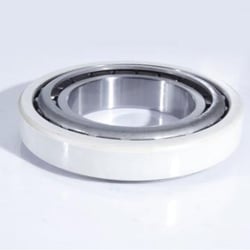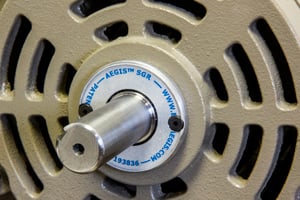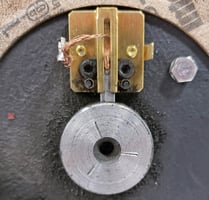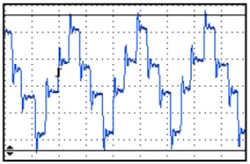Part 3 in a series of questions and answers from our Q&A webinars.
Q: If you use insulated bearings without an SGR, where will the current from the shaft go?
A: First off, there are two levels of insulated bearings.
"Insulated bearings" per se have an aluminum oxide coating on the outer or inner ring - for example, SKF's INSOCOAT bearings. The rolling elements are steel. Their cost is about 3-5 times a standard bearing. The electrical resistance of the aluminum oxide coating is high, from 5 to 150 MΩ (megaohms). But it is still possible to get shaft voltage building up enough to cause arcing through the steel parts of the bearing.
There are also hybrid or ceramic rolling element bearings. These have steel rings and ceramic balls (rolling elements), and are essentially electrically inert (~ millions of MΩ). If you put two ceramic bearings on the motor, then current cannot pass through the bearings, period. One downside is that ceramic bearings and couplings are 7-10 times more expensive than standard bearings.
Back to the question, if it can't get through the motor bearings, then how can the shaft voltage discharge? If the motor is coupled to a fan or a pump, the path of least resistance to that current from the shaft will be through the equipment. So the motor bearings will be fine, but the bearings of the coupled equipment will be damaged.
If your primary concern is the coupled equipment - your fans, gearboxes, and pumps - they're typically 2-3 times more expensive than the motor driving them. If you electrically isolate the motor shaft from the frame, with insulated bearings, the shaft voltage from the VFD will still seek a path to ground, and that path is probably going to go through that expensive coupled equipment. Insulated bearings protect the less-expensive part of the system and leave the more expensive parts vulnerable.
This can be prevented with an electrically insulating ceramic coupling between the motor shaft and the driven equipment. But like ceramic bearings, ceramic couplings are expensive, again 7-10 times the cost of an ordinary steel coupling.
It is more economical to protect small motors and their driven equipment with an AEGIS® Shaft Grounding Ring. By bleeding voltage off the shaft, the ring protects both motor and equipment bearings. Motors over 100 hp (75 kW) are prone to high frequency circulating currents, as well as shaft voltage discharge damage. For these larger motors, we recommend one bearing with outer ring insulation to interrupt the circulating current, along with an AEGIS ring to take care of the shaft voltage.
So insulated bearings are limited, but they're definitely better than nothing at all. We recommend one of them, in conjunction with a grounding ring, because they're much less expensive, but still protect adequately against circulating currents.
Q: How do AEGIS rings compare against carbon brushes for shaft grounding?
A: We recently published a full blog post on this. In brief: Carbon brushes are 100 years old. Nowadays carbon brushes have different composition and holder designs, but they're basically the same technology. AEGIS rings were patented in 2005. Over the past 15 years, they've become the globally dominant shaft grounding technology.


Shaft Grounding Rings, on the other hand, use conductive microfibers in contact with the shaft. They're not under pressure, so they don't wear or generate dust appreciably. Given that they don't require adjustment, they can be installed inside motors, and in fact we recommend that. Our lab testing indicates a lifetime of 100,000 hours, which is over 11 years. And AEGIS Shaft Grounding Rings are the only electrical bearing protection product to offer a two-year extended warranty.
Q: Does VFD carrier frequency have any effect on the rate of bearing degradation?

A: The higher the carrier frequency, the more damaging. But it's impossible to dial it down low enough to eliminate EDM.
EDM is caused by high shaft voltage. The size of the shaft voltage is controlled by the size of the common mode voltage (CMV). The larger the CMV, the larger the shaft voltage. The CMV's maximum (see figure) is primarily determined by the dc bus voltage, although higher carrier frequencies can increase it by reflected wave effects.
But whatever the carrier frequency, if the CMV and shaft voltage get high enough, EDM damage will occur.
AEGIS Rings also come with a 2-year extended warranty against bearing fluting damage. No other form of protection against VFD-caused bearing damage offers a warranty like this.

To learn more about AEGIS shaft grounding and best practices for electrical bearing protection, sign up for a training. We offer monthly live training webinars, and - pandemic restrictions permitting - we can also visit your facility to review your exact application.


